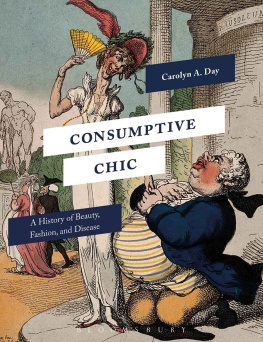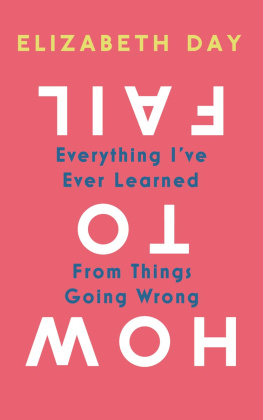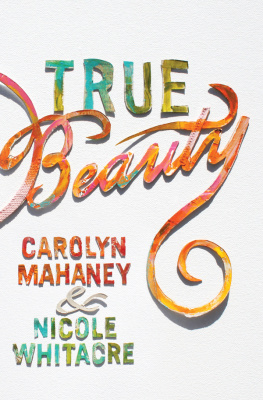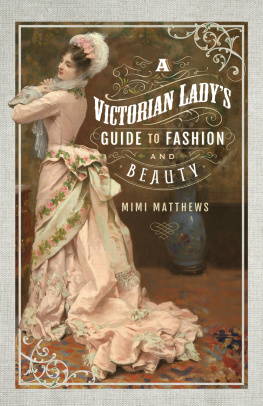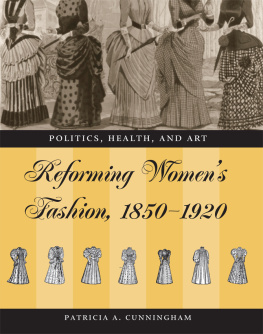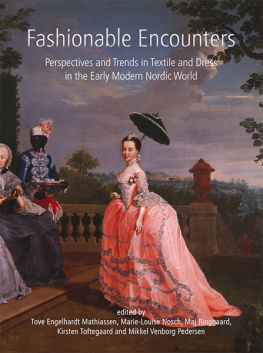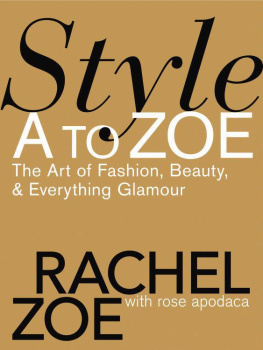
CONSUMPTIVE CHIC

CONTENTS
X-ray of chest showing tuberculosis and photograph of the lungs of a patient after death from tuberculosis (1903).
Gideon Harvey by A. Hertochs (n.d.).
Robert Koch as the new Saint George after isolating the tuberculosis bacillus (c.1882).
Giovanni Battista Morgagni (1761).
A group of young, fashionable doctors (1823).
Sea-bathing was often prescribed for those with delicate constitutions (1813).
A man suffering from gout (represented by a group of dancing blue devils). (1795).
Portrait of St. John Long and a Letter from a Consumptive (1828).
St. John Long dressed as a funeral mourner (1830).
Caricature of A Galloping Consumption (19th century).
Sir Alexander Crichton and the Iodine Inhalation Apparatus (c.18301870).
Lodging House in Field Lane (1848).
Death points an arrow at a female dancer (1832).
John Brown by J. Donaldson after J. Thomson (18381840).
Table of Excitability (1795).
George Cheyne (1732).
Margaret Emily Shore after unknown artist (c.1838).
Mourn Not your Daughter Fading (18421865).
A family group in their drawing room at evening prayer (c.1846).
A baffled doctor taking the pulse of a love-sick young woman (19th century).
Portrait of Maria Siddons (1831).
Hot-well House and St. Vincent Rocks (n.d. early 18th century).
Portrait of Thomas Lawrence, after a self-portrait (1812).
Illustration for Richardsons Clarissa (1785).
Dropsy Courting Consumption (1810).
Capturing the Window to the Soul (early 19th century).
Deadly Nightshade (Atropa belladonna) (1855).
George Combe (19th century).
Dont make it any Redder Mem, Else they will think you paint (1845?).
Innocence is the Best White Paint. The Ladys Toilet (c.1845).
Romantic 1830s hair and Sentimental 1840s styles with instructions for attaching false hair (1831 and c.1840).
The Graces in a High Wind (1810).
Caricaturizing the Naked fashions (1796).
A Naked Truth or Nipping Frost (1803).
Early nineteenth-century sandals (18061815).
The fashionable hump and prominent shoulder blades reminiscent of the winged-back appearance of consumption (1811).
Progress of the ToiletThe Stays (1810).
Martha Gibbon, Stays for Women and Children (1800).
Romantic fashions (c.1836).
Waist and Extravagance (1829).
Romantic era corset (c.18251835).
Woman turning a wheel to make a young girls waist smaller (c.1830).
Contrasting the natural skeleton with the shape of the modern boarding-school miss (1833).
Gardner stays for support (1822).
Richard Kingdon, Apparatus for the Support of the Human Body (1840).
Elastic stays for women and children (1815).
Example of a sentimental style of corset (c.18401850).
Contrast of the Deformed corsetted waist versus that of the Natural uncorsetted waist (1845).
The stoop-shouldered sentimental style that emulated the consumptive bodily conformation (1842).
Hon. Mrs. Mary Graham (17751777).
Day Dress worn by Hon. Mrs. Graham (c.17901792).
Pulmonary tubercle (2nd half 20th century).
Macrophage engulfing TB bacteria (n.d.).
Laennec-type monaural stethoscope (18511900).
Robert Carswells illustration of the tuberculous lung (1838).
Horace Walpole by Sir Joshua Reynolds (c.17561757).
Emily Bront who perished from consumption in 1848 (c.1833).
Skeleton in pink dress (18221856).
Cupping set with scarifier (18011900).
Leeches (18311859 and 1827).
The eighteenth-century nervous system (1796).
John Keats by Joseph Severn (1819).
Tom Keats, nineteenth century.
Wax anatomical Venus (17711800).
Mrs Siddons with the Emblems of Tragedy (1793).
Portrait of Sally Siddons by Sir Thomas Lawrence (c.1795).
Caricaturizing the pigeon-breasted fashions (1786).
1790s fashions (c.1790?, 1794).
Windows of the Soul (1846).
A map of the open country of womans heart (18331842).
English example of neoclassical dress with train (front and back) (c.1803).
Fashion plate illustrating the highlighting of the dcolletage and posterior furrow (1810).
Dress illustrating the low back that would have showcased the backbones (1809).
Short diaphragm-length pair of stays (c.1790).
Day Dress (c.18301834).
Example of Sentimental Dress (18451850).
Romantic and Sentimental decoration for Evening Dress (1832?, 1848).
Romantic and Sentimental decoration for Day Wear (1830?, 1845).
Stooping posture reminiscent of consumption (1842).
Marie Duplessis (18241847).
Dress (c.18531862).
Hygean or Corporiform Corset (1849).
Front and back views of a new style of Reformed corset (1851).
This book has been a labor of love that has kept me constantly entertained for more than a decade, and would not have been possible without the assistance of more people than I have room to thank. Most importantly, thank you to my amazing family for believing in me when I chose to change disciplines and follow my heart. I am so very grateful to you, mom and dad, for teaching me to chase my dreams and to persevere in the face of whatever obstacles come my way. Donal, Lorraine, Benjamin, and Emily this book is dedicated to you and is a testament to your love and support. To my beloved niece and nephew, Avalyn and Brennan, thank you for being so excited about Aunt Nee Nees book and constantly wanting to be a part of the process. Your enthusiasm as I trudged through archives, and thirst for the stories I uncovered, has made the process all the sweeter. It is hard to believe that you are the same age as the project and watching you grow up as the book did has been incredibly special.
The encouragement and assistance I have received from other academics and friends has been invaluable, both to my development as a scholar as well as to Consumptive Chic. To my current and former colleagues and wonderful friends, thank you for your constant advice and support as I navigated academic life and the ins and outs of publishing. Special thanks must go to Dr. Mark Smith for your championing of a young scholar and to Dr. Hugh Belsey and Claudia and Robert Maxtone-Graham for their kind assistance with Mary Grahams dress.
I am extremely grateful to Dr. James Secord for encouraging this project when I first stumbled across the idea and words cannot express what the constant support of Dr. George Bernstein has meant to me. Thank you for taking a chance on me, not only as your student but also for being willing to back a dissertation on the strange juxtaposition of fashion and disease. I would also like to thank Dr. James Boyden and Dr. Alisa Plant who championed this book when it was only a dissertation proposal. Your friendship and wisdom have been invaluable and are so appreciated. I have also been the beneficiary of the generosity of so many archivists, but a special thank you must be given to the wonderful staff of the rare books room at the Cambridge University Library who aided me in making the most of my time in the archives. To that same end, thanks to my amazing friend Dr. Renae Domaschnez who made those brief trips possible. Just as I was slated to begin my research, Hurricane Katrina hit New Orleans closing Tulane University and wiping out my funding. Renae rescued me, and my academic career, by offering me a free place to stay on that first trip and on many subsequent visits to Britain. Special thanks must also go to my friend Dr. Steve Mason who has subsequently put me up on numerous research trips making both this and my next book possible.
Next page
